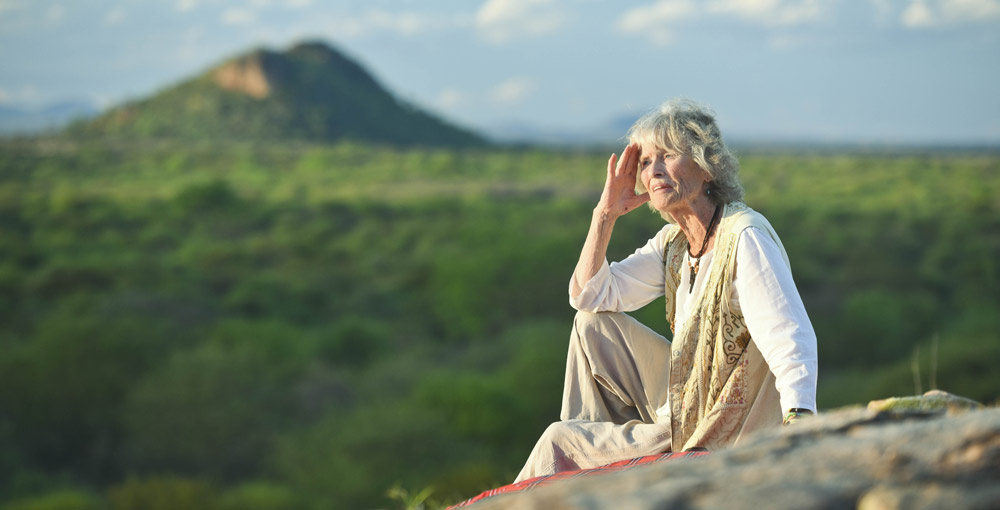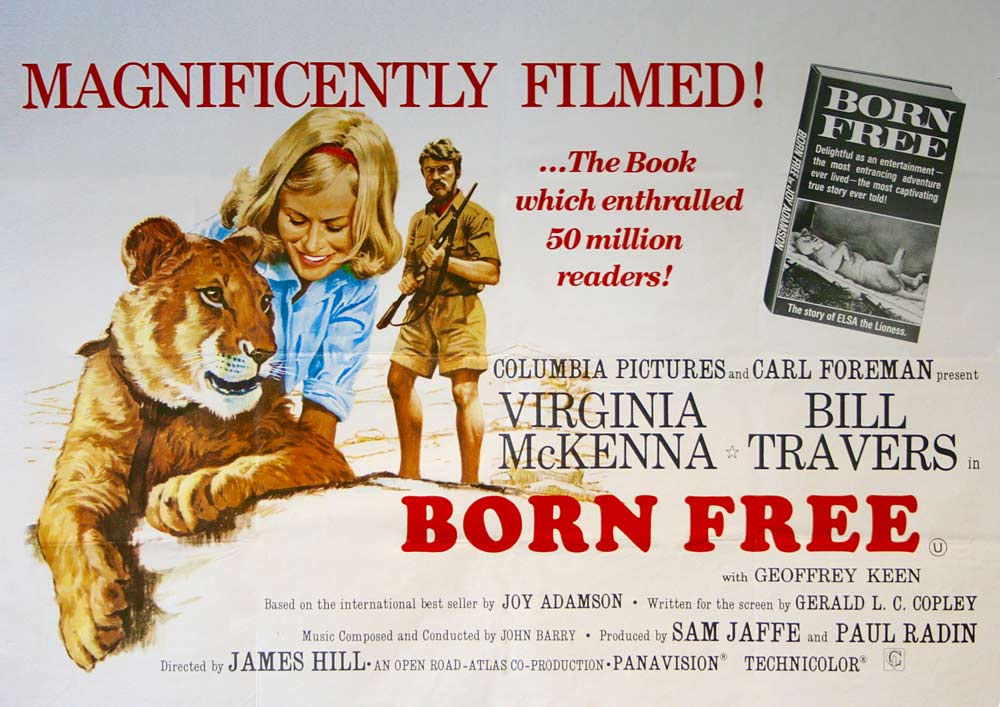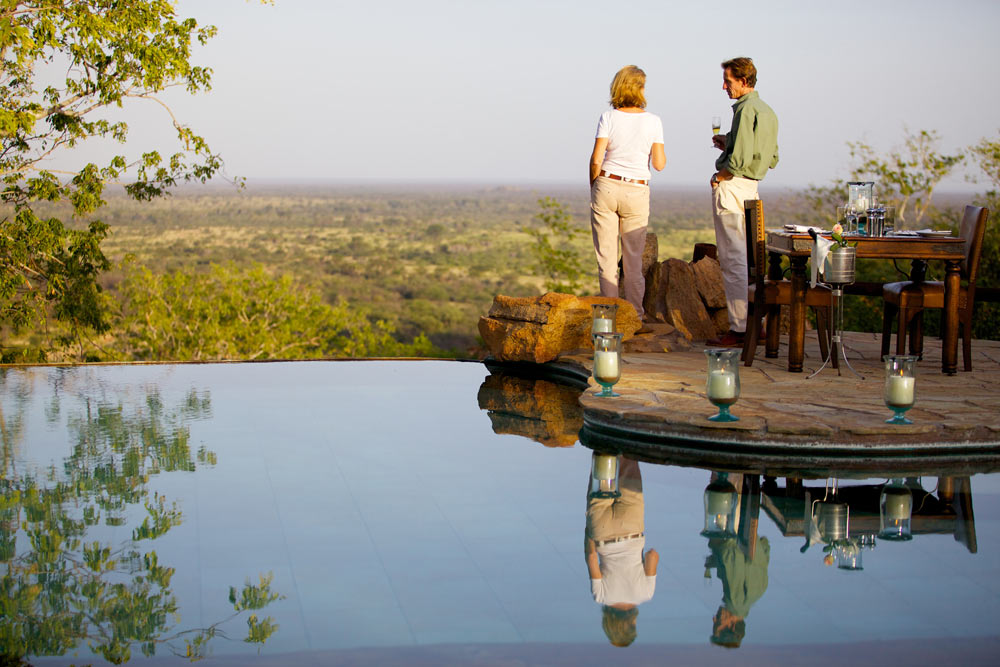In this article, actress and activist Virginia McKenna OBE, who played Joy Adamson in the 1966 film, Born Free, tells us how her time spent in Kenya whilst filming Born Free changed her life.

Virginia McKenna is a British stage and screen actress, author and wildlife campaigner, best known for such films as A Town Like Alice, Carve Her Name with Pride and Ring of Bright Water. But it was her role alongside her husband, Bill Travers, in the 1966 classic Born Free that was to change everything.
The film was based on the book, Born Free, by Joy Adamson, a worldwide best-seller read by 50 million people and translated into 21 languages. Born Free told the true-life tale of game warden, George Adamson, who adopted an orphaned lioness cub, Elsa, and Joy Adamson, who formed a unique relationship with her. Set in the Meru National Park, in northern Kenya, it was the most successful animal story of modern times.
The film also brought huge publicity to Kenya as millions all over the world saw, for the first time, the glory of her wilderness and wildlife. Finally, the story of Elsa the lion cub served as a catalyst for the cause of animal conservation and also earned Virginia the title, ‘the midwife of animal conservation’.

Born Free – first impressions of Kenya
You first came to Kenya in 1964 with your husband, Bill Travers, to begin work on the film, Born Free. Together you then spent 9 months living in the bush, living alongside lions and preparing for your roles. What were your first impressions of Kenya and how did those impressions change during your stay?
Where do I begin? It was a very long time ago – 55 years in fact – that Bill Travers and I sailed from London to Mombasa with our children to begin work on a film called Born Free, based on Joy Adamson’s famous book on her life with George Adamson. George was our ‘lion man’ and I have to say that without his quiet wisdom and sensitive guidance the film could never have been made.
We had to work closely with six different lions after the two circus lions that had been selected to ‘play’ Elsa were deemed too unpredictable. This meant that we had to get to understand them – as individuals – and form relationships with every one of them. Our family home (and the base for the lions) was an old settlers’ house on a little river in the town of Naro Moru. My first memories of Kenya are of the great beauty of the land and the warmth and kindness of all the people we met. Also of the cloud-filled skies which, for some reason, never seem to obscure the sun. They’re memories that are echoed every time I return to Kenya.
Getting to know lions

You’ve been quoted as saying that making Born Free in Kenya had a tremendous impact on you and Bill. Could you tell us more?
It would have been impossible for anyone not to have been affected by the making of a film of Joy’s book, it was a love story. It was also the story of a relationship between a lioness and two extraordinary people and the unique and unpredictable journey they travelled together. For Bill and I, it was a leap into the unknown because we had to understand the different natures and traits of all the different lions who ‘played’ Elsa.
You’ve spoken about the fact that no matter how much you had read about lions, nothing had prepared you for the reality of meeting a lion.
Nothing can prepare you for the moment you actually meet a lion. How could it? Animals are all different – just like us – and you need, slowly but surely, to learn about their likes and dislikes; when they are bored or uninterested; whom they like or don’t like.
A lasting impact
What are your abiding memories of your time in the Kenyan wilderness and what, if anything, evokes your strongest memories of Kenya?
During the months of filming in Naro Moru we had no time to travel and experience ‘the wild’. But once filming was over we took our two eldest children, Will and Louise, on safari in Kenya and Tanzania. It was an experience never to be forgotten: not only of seeing such iconic creatures as elephant, lion, rhino, cheetah, giraffe, but also of encountering the birds, herbivores and the miraculous dung beetle, which will always remain one of my very special creatures.
In your journals, you wrote about how leaving Africa was ‘agony’, as was saying goodbye to the many ‘Elsas’ who starred in the film. Can you elaborate?
We worked with over 20 lions and had close and extraordinary relationships with a number of them. So you can imagine our horror and disbelief when, at the end of filming, we were told that they had been sold to a series of zoos and safari parks. Joy and George shared our horror, but it was too late – the deals had been done.
We did, however, manage to save two lions called Boy and Girl. Also a large male called Ugas who joined George’s little pride of lions. The other lions were not so lucky: our much-loved Mara and Little Elsa went to Whipsnade Zoo in England while fun-loving Henrietta was returned to Entebbe Zoo in Uganda.
Our sense of having betrayed these creatures ran very deep. So deeply, that Bill decided to make a documentary about our visit to Mara and Little Elsa at Whipsnade Zoo. It was an experience I will never forget. It was also the inspiration for the many documentaries Bill would make over the coming years and which opened up a new path in life for him.
As for George, a friend for life, he set up a simple camp in Meru where he cared for the three lions we had saved. You can still see the site today. It lies just below the current lodge, Elsa’s Kopje, a beautiful place where I stay every time I visit Meru. You can also still see the rusting remains of George’s various vehicles as they lie in the bush – poignant reminders of the path that would ultimately lead to his tragic death.

Born Free and Living Free
You’ve said that every creature, human and non-human, deserves to be born free and stay free. Could you tell us how you’ve translated this belief into the establishment of the Born Free Foundation?
I have always found it challenging to accept that wild animals can be kept in captivity; that they can be removed from their mothers and sent to zoos in distant lands, that they can be subjected to living in cages or enclosures; and that they can be denied companions of their own kind and required to mate according to the dictates of man.
Worse still that they should be sold to circuses, which are really travelling menageries where they are trained to perform tricks such as standing on tubs, jumping through hoops or riding horses with loud music blaring around them. Surely such spectacles belong to history. I also question how we can watch wildlife documentaries – in wonderment – and yet still approve of wild animals being kept in captivity?
The spirit of Elsa
Born Free was released in 1966, would you say that the understanding of wild animals – their natures, needs and desires – has improved dramatically since then?
I think that a growing number of people do think very differently now – especially when they hear about the rescues that we, and other groups, have carried out; such as ensuring that wild animals be removed from concrete cages, circus trailers or private ‘ownership.’ But the horror stories still continue. And many of them are not only condoned but also compounded by the extraordinary indifference displayed by those in positions of authority.
It is also true that fewer circuses use wild animals in the United Kingdom, though the same does not apply elsewhere in the world. There is also the fact that as the human population increases so the availability of land for the wildlife decreases, and this leads to conflict between man and wildlife and between the wildlife itself.
Perhaps it’s time for the spirit of Elsa to be reborn; time for people to learn to respect and treasure our wildlife and wildernesses; and to conserve the natural world, whose beauty and seasonal change so enriches our souls. I may be an eternal optimist, but I am always encouraged by my visits to Kenya where I rejoice in the beauty of the land and its creatures.
I’m also encouraged by my meetings with the school children who already care so deeply about wildlife – despite the fact that many of them have only encountered it in the form of pictures. I recall one particular young boy, who asked, ‘Please Miss, why do men kill lions?’
The Born Free Foundation
Born Free changed many lives, but especially those of Virginia and Bill who devoted their lives to campaigning for animal rights and to the establishment of the Born Free Foundation. Today, the Born Free Foundation has 100,000 supporters worldwide and spends more than £2 million every year fighting animal exploitation, conserving endangered species, and re-homing animals from run down zoos to Born Free sponsored sanctuaries all over the world.
For further information visit: www.bornfree.org.uk
© 2025 Kenya Holidays
